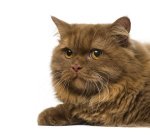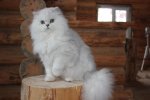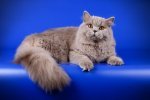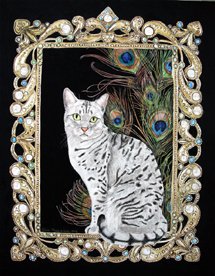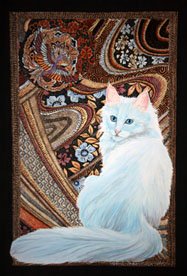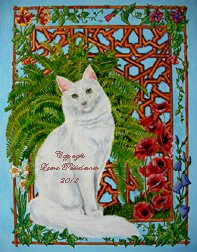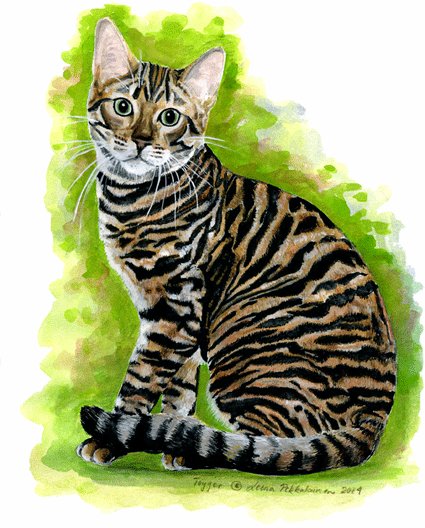Siamese Cat Colors
The Siamese cat colors are perhaps the most unique in the cat world - everyone knows the Siamese The Siamese cat has "points" which means its extremities are of a darker color than the coat. This pointed color scheme is also called color restriction.
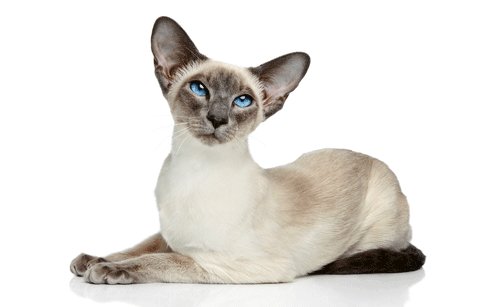 |
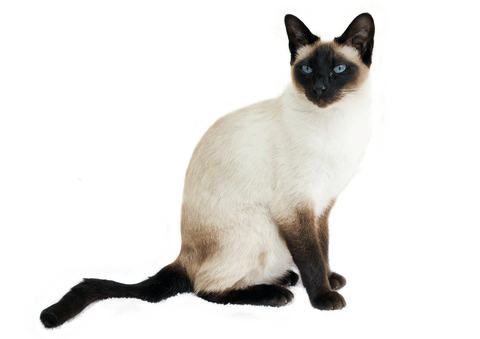 |
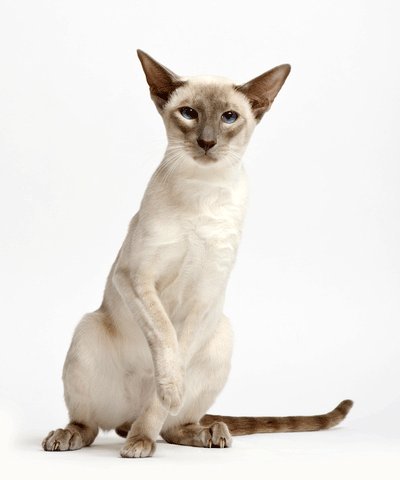 |
The points of color are in the face (called the mask), the ears, the legs and feet and the tail. The edge between the pointed, darker color and the paler coat color is subtle, with gradual blending. The color in the points is to be dense, and all points are to be of the same shade. There is to be no ticking or white hairs.
The lighter fur is to be creamy / white, and the body color is to be even. Older cats may be a bit darker in color (a lighter shade of the point color), but the contrast between the body and point colors should be there. As the sharper contrast looks better, usually the show cats are young. Especially the seal and blue points darken faster, whereas chocolate and lilac points darken slower, and stay in the ring a bit longer.
The markings and color develop slowly, so the Siamese cat colors are not ready until the cat is at least one year old. The mask, for example, is small on a kitten and grows as it ages. When ready, the mask covers the whole face, including the whisker pad, and goes around the eyes. It should not, however, extend over the top of the head.
The gene causing the Siamese cat color points is recessive - this means that to produce a pointed kitten, both parents need to be pointed. The pointed pattern is caused by partial albinism, which is caused by an enzyme mutation (the enzyme called tyrosinase to be exact, which is involved the the production of melanin). This enzyme is heat sensitive, activating in cooler areas. So you see darker color in the cooler areas of the cat. This means the legs, tail and face. (Why the face? The breathing air in the sinuses cools the face)
There are 32 Siamese cat colors and patterns in all. Different cat breed organizations accept different Siamese cat colors, so if you are planning on buying a show cat, check which colors are accepted in your country.
The main Siamese cat colors are Seal, Chocolate (these two are the original colors mentioned in the Cat-Book Poems), Blue (a dilute of the Seal color), Lilac (a dilute of the chocolate color, also called "Frost), Apricot, Fawn, Caramel, Cinnamon, Cream, Red, Tortoiseshell (or "Tortie") and Tabby (or "Lynx").
All Siamese kittens are cream or white colored when born. The colored points take a few weeks to develop, and only then you can say what color it is.
Seal Point
The seal point is the one people usually think about when Siamese cat colors are discussed.
The extremities are seal brown, almost black. (If the points are of a cold black color, it is considered a flaw.) The points match in tone on all points. This cat also has the darkest body color of all Siamese cat colors, but the contrast between the points and the coat color is nevertheless clear.
Genetically speaking the Seal point Siamese is a black cat, but the genes cause the color only to show on the points. There should be no black or grey in the points.
The body color of the Seal Point Siamese is from pale fawn to cream - pure white color is incorrect. Shading should be warm fawn, which gradually turns into lighter color on the chest and stomach. The Seal Point has the most variation in color shades - at its lightest the coat color can be almost white, at its darkest the body color can be almost dark brown. While still a kitten, both the points and the coat color can be a bit muddy, but this clears when the cat gets older. At kitten-stage the Seal and Blue Siamese can look similar, and the same goes for Chocolate and Lilacs. (After all the latter ones are dilutes of the previous color.)
Nose leather and paw pads should be seal brown.
Chocolate Point
The Chocolate Point was accepted into Siamese cat colors in cat shows in the 1950s.
The body color of a Chocolate Point should be ivory white, and there should be no shading. The lack of shading makes the contrast between the body and the points more dramatic.
As a kitten, it takes a longer time for this color to develop than Seal Points. The points are of milk chocolate color, and all of even color - no lighter or darker points. The bodies are of warm tone, creamy ivory white. The Chocolate Point's coat color tends to stay lighter that the Seal's as they age.
The nose leather and paw pads should be cinnamon-pink (pinkish chocolate).
Blue Point
This color was officially recognized in 1934 into Siamese cat colors.
The body color of a Blue Point is bluish white - a cold color that shades gradually towards white on chest and stomach. It also shades gradually into blue on the back, the same cold color as the points, but a lighter shade. When the cat ages, the coat color can get quite dark.
The points are of deep, slate blue, all points of similar color.
The nose leather and paw pads should be slate blue.
On a side note - the Blue Point is said to be the most affectionate of the Siamese.
Lilac Point
It may be the first Lilac Point Siamese was exhibited as early as 1896. The cat was described as "not quite blue".
Lilacs were the third official colour accepted into Siamese cat shows - this happened in 1955.
The points are of pinkish, frosty grey. This is why this color is also called the Frost Point. The points should not be blue, chocolate or fawn.
The coat color of the body is glacial white with no shading (the color is also called Magnolia). Lilac points have the lightest body color of all Siamese colors, and they also remain light colored when they age. Still, a cold white color is not desired. The tail may have some rings - this is not desired, but not a serious fault.
The nose leather and paw pags of a Lilac Point are of a pretty lavender pink color.
All in all the Lilac Siamese is a very delicate looking cat.
 |
 |
 |
Siamese Cat Colors:
Colorpoint Shorthairs
Other than CFS, cat associations consider these cats Siamese.
Red Point
The Red Point was originally created in the 1930´s by crossing a Siamese cat with red tabby and tortoiseshell British Shorthairs. First Red Points were exhibitied in 1934 in Britain.
The points are of bright reddish gold color. The body is warm white in color.
The nose leather and paw pads are pink.
Red Points were previously also called Orange Points.
Tortie Point
Just like the Red Point, the Tortie Point Siamese was created in the 1930's by crossing Siamese cats with red tabby / tortoiseshell British Shorthairs.
The points are a mix of black or red or their dilutes.
Torties are almost always female.
Lynx Point
Of Siamese cat colors, this color was created through breeding Seal Point Siamese with domestic tabby cats. (The story goes that the first Seal Lynx Point kitten was the result of an accidental breeding of a Seal Point female in 1960) Officially Lynx Points were recognized in cat shows in 1966 in Britain.
The points are striped. There colors vary ad include all Siamese colors: there are red lynx, seal lynx, cream lynx, lilac lynx, blue lynx, chocolate lynx, lilac tortie lynx, blue tortie lynx and seal tortie lynx Siamese.
Cinnamon Point
The points are of a warm, cinnamon brown. The legs may be a lttle paler. The body color is ivory, shading to tone with the points. Nose leather and eye rims are of cinnamon brown. The color of the paw pads is from pink to cinnamon brown color.
Caramel Point
Points are of a brownish grey color (in lilac / fawn based coat) or dark brownish blue (in blue based). The points should match, but he legs can be a bit paler.
The body is off-white, and any shading should be i tone with the points.
The nose leather, eye rims and paw pads are pinkish grey.
Fawn Point
The Fawn Point Siamese is one of the most delicate of Siamese cat colors - it has beautiful pale, rosy mushroom points of warm tone. The legs may be a bit paler. The body color is off-white (also called magnolia), and if there is any shading, it should tone with the points.
The nose leather, eye rims and paw pads are of pinkish fawn color.
Cream Point
Cream Points were produced by crossings between Siamese, Abys and red Domestic Shorthairs.
The points are the color of cool cream, and the body is, of course, creamy white. The nose leather and paw pads are delicate pink. Among one of the most delicate of the Siamese cat colors.
Apricot Point
The points are of hot cream with a soft metallic sheen - this becomes more obvious when the cat gets older. The legs and feet are a bit paler in color, but there should be definite color at the rear hind legs below hocks. There can be barring and striping in the mask, legs and tail.
There may be freckles on the nose, the pads, lips, eyelids and ears.
The body color is warm creamy white. If there is any shading, it should tone to points. The shading may be uneven.
Eye rims, nose leather and paw pads are pink.
 |
 |
 |
Siamese Cat Colors:
Tabby Points
Tabby points are tabby versions of any of the nine basic Siamese cat colors.
On the face there should be clearly defined striped markings, especially around the nose and eyes. There should be a distinct M on the forehead. The whisker pads should also be darkly spotted, and there should be clear stripes / ribbons on the cheeks of the cat. These stripes should not extend over the top of the cat's head.
The ears can have the "thumb print" pattern, but the edges should have the same color as the markings on the mask. In dilute colors, these thumb prints are not so clear, and in tortie tabby points it may be they are not visible at all.
The leg markings can be somewhat paler in color (especially in red and cream tabbies). They are broken stripes of various sizes. The markings should be solid on back hind legs.
The tail should be ringed all around, also on the underside. These rings should be visible for the whole length of the tail, and the tail should end in a darker tip (in tortie tabby points the tip may show tortie markings).
In kittens, the markings are usually paler.
The body color should be solid, and fit the colour of the points. There should be clear contrast to the points. If there is any shading, it should show the underlying tabby pattern.
Seal Tabby Point
The points should be of a clear seal-brown color, almost black (but not quite). The eye rims are seal brown or black. The nose leather is seal brown or pink which is rimmed with seal brown color.
The paw pads are of seal brown or pink color.
The body color is cream, which deepens to warm pale fawn color on the back. If there is tabby shading, it should tone with the points.
Blue Tabby Point
The points are of clear light blue with tabby markings. The eye rims are blue. Nose leather is either blue or pink rimmed with blue.
Paw pads are blue or pink.
The body color is glacial white, which deepens on cool blue on the back.
If there is any tabby shading, it should tone with the points.
Tortie Tabby Point
This can be of any basic color but red or cream. The tabby markings are overlaid with patches of red or cream, which gives the effect of mingled colours; the points are mottled.
Also the nose leather and paw pads can be mottled.
The body color is solid, fitting the color of the points.
Chocolate Tabby Point
The points are of clear chocolate color with an almost copper tone. Cold or dark brown is incorrect, the points should not be seal.
Eye rims are chocolate, as is the nose. The nose can also be of pink color, rimmed with chocolate.
The paw pads are either chocolate or pink.
The body color is ivory with tabby shadings that should tone with the points.
Lilac Tabby Point
The points have clear pinkinsh-grey tabby markings. The eye rims are faded lilac color.
The nose leather is either faded lilac or pink, which is rimmed with faded lilac.
The paw pads are of faded lilac or pink color.
The body color of a Lilac Tabby Point is off-white (also called magnolia). If there is any tabby shading, it should tone with the points.
Red Tabby point
The points: clear bright reddish-gold tabby markings.
The eye rims, nose leathr and paw pads are all pink. There is a possiibility of freckled on the eyelids and ears, nose and pads.
The body color is white - if there is any tabby shading, it should tone with the points.
Cream Tabby Point
The points are of a clear cool cream tabby markings. Warm color is incorrect.
The eye rims, nose leather and paw pads are pink. There may be freckles on the eyelids and ears, nose and pads.
The body color is white, which deepens to pale cream color on the back and on the sides. If there are any tabby shadings, they should tone with the points.
Cinnamon Tabby Point
The markings should be clear, warm cinnamon tabby markings.
The eye rims are of cinnamon brown. The nose leather should be cinnamon brown or pink rimmed with cinnamon brown.
Paw pads are of cinnamon brown or pink.
The body is of ivory color, and if there is any tabby shading, it should tone with the points.
Caramel Tabby Point
The points should be clear dark brownish blue (in blue based) or brownish grey (in lilac / fawn based) tabby markings.
Eye rims are of pinkish grey color. Nose leather is either pinkish grey, or pink rimmed with pinkish grey.
The paw pads are of pinkish grey or pink.
The body color is off-white, and if there is any tabby shading, this should tone with the points.
Fawn Tabby Points
The points are clear, warm, pale rosy mushroom color.
The eye rims are of pinkish fawn color. The nose is the same, but can also be of pink color rimmed with pinkish fawn.
The paw pads are of pinkish fawn or pink.
The body color is off-white (magnolia), and if any tabby shading, the color should tone with the points.
Apricot Tabby Point
The points are a clear, hot cream tabby color. A soft metallic sheen becomes apparent when the cat gets older.
The eye rims, nose leather, and paw pads are all pink. There may be freckles on the eyelids, ear, nose, pads and lips. The body is of a warm creamy white tone, and as with other tabby points, if there is any shading, it should be in tone with the points.
Seal Tortie Tabby Point
The points are of clear seal brown or black color, patched and / or mingled with shades of red. The ears can be mottled too.
Eye rims are seal brown or black and/or pink. The nose leather and paw pads are of seal brown and/or pink color.
The body color is cream, which deepens to a pale warm fawn on the back. If there is any tabby shading or tortie patching it should tone with the points.
Blue Tortie Tabby Point
The points are clear light blue tabby markings, randomly patched and/or mingled with shades of cream, The ears can be mottled.
The eye rims, nose leather and paw pads are blue and/or pink.
Body color is glacial white which deepens to cool ight blue on the back. If there is tabby shading and tortie patching, these should tone with the points.
Chocolate Tortie Tabby Point
The points are clear chocolate tabby markings. These can be almost coppery in tone, and should not be cold, seal of dark in color. These points are patched and/or mingled with red shades. The ears can be mottled.
The eye rims, nose lather and paw pads are chocolate and/or pink.
The body is of ivory color, and if there is any tabby shading or tortie patching, it should tone with the points.
Lilac Tortie Tabby Point
The points are clear, pinkish-grey tabby markings. These are patched and/or mingled with shades of cream. The ears may be mottled.
The eye rims, nose leather and paw pads are of faded lilac and/or pink color.
The body is off white (magnolia) in color.
If there is any tabby shading or tortie patching, these should tone with the points.
Cinnamon Tortie Tabby Point
The points are of clear warm cinnamon brown tabby markings. These are patched and/or mingled randomly with shades of red. The ears may be mottled.
Eye rims, nose leather and paw pads are of cinnamon brown and/or pink.
The body is of ivory color. If there is any tabby shading and tortie patching, these should tone with the points.
Caramel Tortie Tabby Point
The points are clear dark brownish blue (in blue-based) or brownish grey (in apricot-based) tabby markings. These are patched and/or mingled at random with shades of apricot. The ears may be mottled. The eye rims, paw pads and nose leather are of pinkish grey and/or pink color.
The body color is off-white (magnolia), and if there is any tabby shading and tortie patching, these should tone with the points.
Fawn Tortie Tabby Point
The points are clear warm, pale, rosy mushroom tabby markings. These are patched and/or mingled at random with chades of cream. The ears may be mottled.
The eye rims, nose leather and paw pads are of pinkish fawn and/or pink color.
The body color is off-white (magnolia). If there is any shading and tortie patching, these should tone with the points.
 |
 |
 |
Siamese Cat Colors:
Tortie Points
The tortie points of the Siamese cat colors can be of any basic color but red or cream. The points are mottled with red or cream or apricot hairs (compare to Tortie Tabby Point where the points are mingled with patches of red or cream). Each point must show some break of color, despite the size of the point. Large areas may show striping.
Nose leather and paw pads can be of even color of mottled, and should match the points.
The body color is solid, pale, and fitting the main color of the points. It should show clear contrast to points. Any shading shows patching or mingling of color.
The eye rims, nose leather and paw pads fit the base color and/or pink.
Cinnamon Tortie Point
The points are of a warm cinnamon brown color with shades of red.
The body is of ivory color, and if there is any shading, it should tone with points.
Caramel Tortie Point
The points are of dark brownish blue (in blue based) or brownish grey (in lilac/fawn based), with shades of apricot.
The body is off-white (magnolia), and if there is any shading, it should to the points
Fawn Tortie Point
The points are of warm, pale, rosy mushroom color with shades of cream.
The bdy is off-white (magnolia), and if there is any shading, it should tone to points.
 |
 |
 |
Siamese Cat Colors:
Parti-Color
This is a new one among Siamese cat colors - there are pure white spots on legs, body and mask. The points can be blue, chocolate, fawn, caramel or cinnamon in color.
Siamese Cat Colors:
Foreign White
The white overcoat is the dominant mask color - so it is counted among the Siamese cat colors. The blue eyes reveal we are looking at a Siamese.
Back to Homepage from Siamese Cat Colors
Go to Siamese Cat History from Siamese Cat Colors
Space Witches series
The Seven Shabtis series
The Creature Wars series
The copyrights of the photos used are by Jagodka at Dreamstime, Matthewgore at Dreamstime and Isselee at Dreamstime.
Leena's Books
Tutankhamun
|
This book travels with the King Tut - Treasures of the Golden Pharaoh exhibition on his world tour of ten cities from March 2018 onwards |
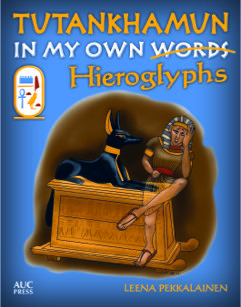 |
|
Tutankhamun: In My Own Hieroglyphs tells the story, for older children, of the life and afterlife of the famous young pharaoh in his own words. Tutankhamun tells us about the trouble he got into as a child in Akhenaten's palace in the new city of Akhetaten, and how he became a boy pharaoh. As we learn, his life changed a lot when he died as a teenager, and long years of boredom started in his tomb with only his pet monkey Fingers and his treasure for company. He did meet some of the Egyptian gods, of course, and had fun scaring off tomb robbers, but it was mostly rather dull. Then one day, some new and strange people, including a Mr. Howard Carter, arrived and began to take all the treasures out of his royal tomb. Fortunately, through the eyes of his beautiful golden mask, Tutankhamun, could have fun again traveling around the world |
Mr Mummific
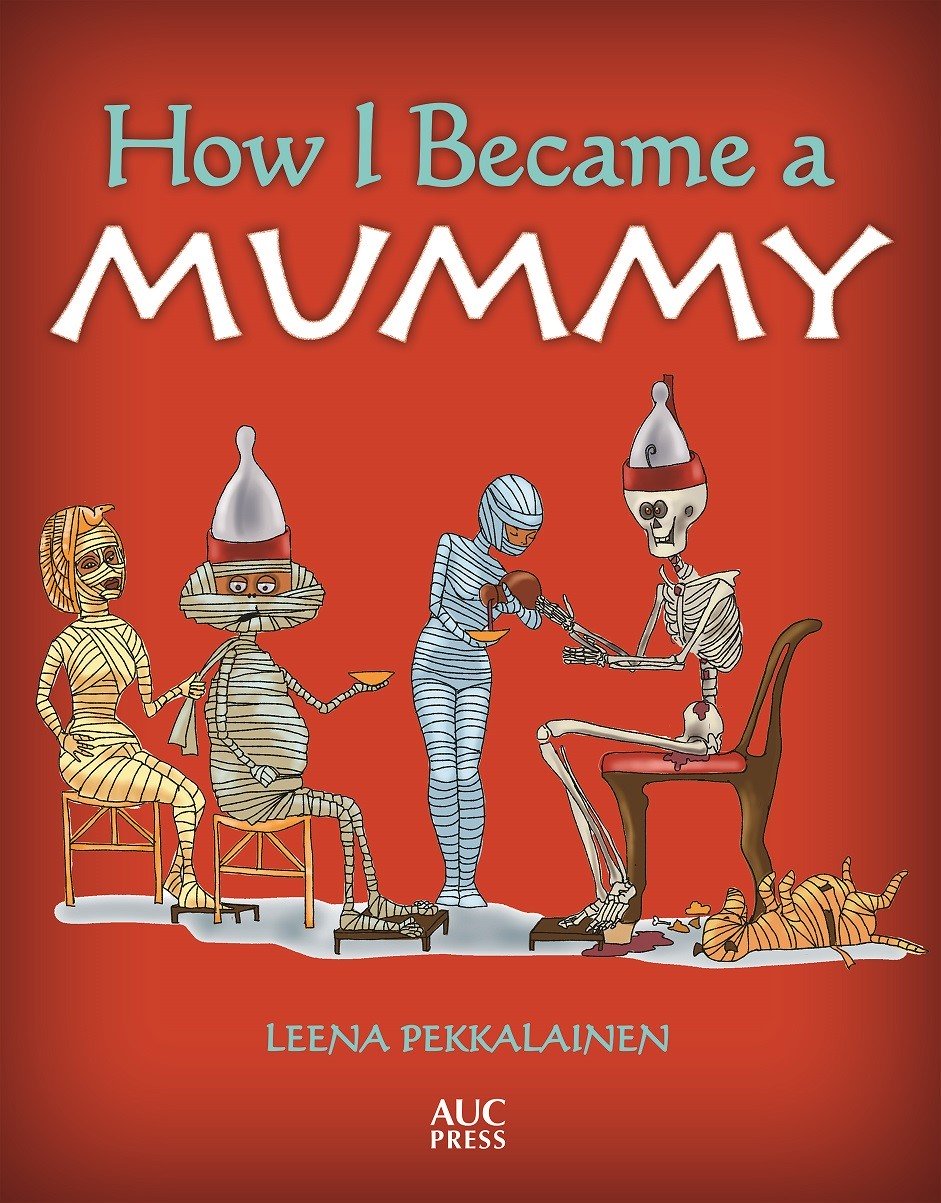
|
An ancient friend of mine, Mr Mummific dictated a book about how he became a mummy - and I was his scribe and artist. The book is available at Amazon.com and Amazon.co.uk On my other website www.ancientagypt101.com he continues his stories about life in ancient Egypt. |
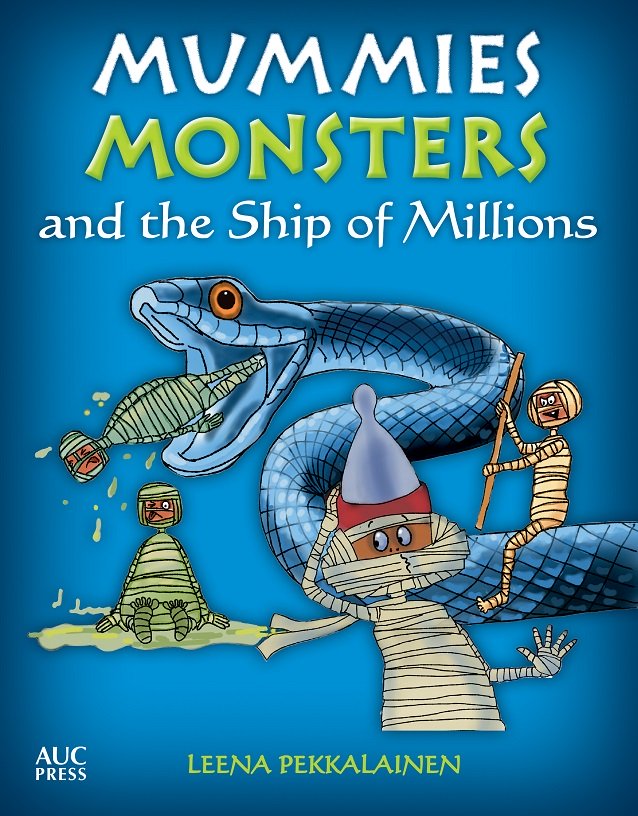
|
Another hilarious adventure for children with Mr Mummific, the mummy with attitude. He now tells the story of his mishaps, misunderstandings and misadventures as he leaves his tomb through the False Door to embark on the complicated and dangerous journey to the Afterlife aboard the magnificent Ship of Millions. Find the book at Amazon.com and Amazon.co.uk |
The Nephilim Quest Series
The first book in an epic fantasy series based on human mythology. The search for the mythical Watchers, the angels who fathered the Nephilim, the half-angels. A story that moves on three levels - our times, ancient Greece and ancient Egypt.
Preview Nephlim Quest 1: Shadowhunter online
***
My Author Website at leenasbooks.com
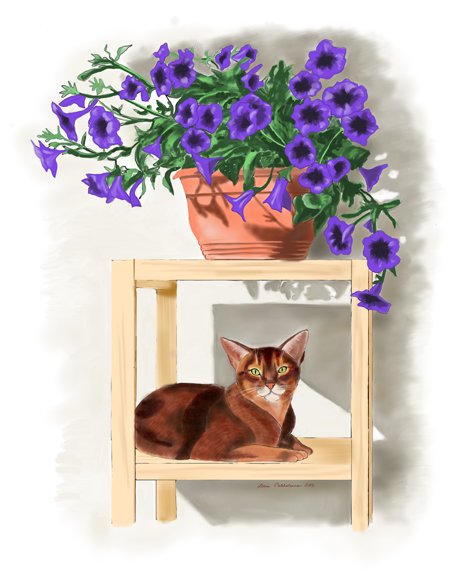
If you are looking for demanding coloring, check:
Online Coloring Books Magazine - No.1
It shows you step by step how to color this pretty Abyssinian cat with flowers. Each page has a color sample, and all the techniques are explained.


